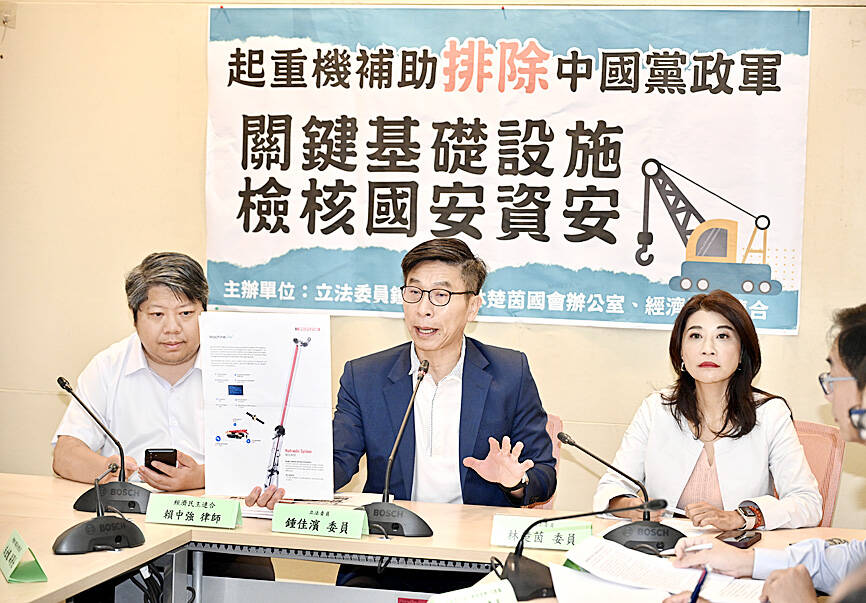The Maritime and Port Bureau yesterday said it would step up inspections of heavy machinery and equipment for construction after lawmakers raised concerns that the use of China-made equipment could pose a security risk.
The government would conduct national security screening against Chinese-made cranes, and ensure that individuals and organizations using such machinery are removed from the eligibility list for subsidies, Democratic Progressive Party (DPP) legislators told a news conference earlier in the day.
The Executive Yuan’s Office of Homeland Security should be checking whether government agencies or critical infrastructure projects are using products, machinery, components and chips from banned areas, DPP Legislator Chung Chia-pin (鍾佳濱) said.

Photo: Lo Pei-de, Taipei Times
Government and critical infrastructure contracts should demand that all contractees provide proof and certification of components’ origins and safety of use, Chung said.
Chinese-made information technology (IT) equipment presents potential security risks and have become a medium through which Beijing collects information, DPP Legislator Michelle Lin (林楚茵) said.
The Ministry of National Defense has banned all Chinese-made products, she said, suggesting that similar bans be implemented across public construction projects and state-owned businesses.
Lin also suggested that the Executive Yuan implement domestic IT security certifications to minimize the risk of outside forces breaking the IT security supply chain.
The government should publicize information about risky companies to better deter enemy forces’ attempts to hack into Taiwanese infrastructure, she added.
Meanwhile, Economic Democracy Union convener Lai Chung-chiang (賴中強) urged the Office of Homeland Security to explicitly ban China-made surveillance equipment and digital billboards, and set a clear timeline for implementing such bans.
Lai also called for the office to establish a certification center to desinicize the IT supply chain industry.
In response, the Executive Yuan’s Public Construction Commission said that labor provision and operation of machinery for construction projects at critical infrastructures or government agencies are controlled via government procurement.
The commission said it would work closely with the Office of Homeland Security to standardize contracts for all projects for government agencies and critical infrastructure.
Of the 431 bridge and gantry cranes in the country, 99 were made in China, the bureau said.
The bureau said it would step up the verification of machinery and software sources for operators. Although there is a reduced IT security risk as operating software is isolated and made by Japan, South Korea or Germany, the bureau has asked the Ministry of Digital Affairs for help and suggestions.
Third parties have been hired to complete audits of machinery used in Keelung and Kaohsiung harbors, the bureau added.

Chinese Nationalist Party (KMT) Chairman Eric Chu (朱立倫), spokeswoman Yang Chih-yu (楊智伃) and Legislator Hsieh Lung-chieh (謝龍介) would be summoned by police for questioning for leading an illegal assembly on Thursday evening last week, Minister of the Interior Liu Shyh-fang (劉世芳) said today. The three KMT officials led an assembly outside the Taipei City Prosecutors’ Office, a restricted area where public assembly is not allowed, protesting the questioning of several KMT staff and searches of KMT headquarters and offices in a recall petition forgery case. Chu, Yang and Hsieh are all suspected of contravening the Assembly and Parade Act (集會遊行法) by holding

PRAISE: Japanese visitor Takashi Kubota said the Taiwanese temple architecture images showcased in the AI Art Gallery were the most impressive displays he saw Taiwan does not have an official pavilion at the World Expo in Osaka, Japan, because of its diplomatic predicament, but the government-backed Tech World pavilion is drawing interest with its unique recreations of works by Taiwanese artists. The pavilion features an artificial intelligence (AI)-based art gallery showcasing works of famous Taiwanese artists from the Japanese colonial period using innovative technologies. Among its main simulated displays are Eastern gouache paintings by Chen Chin (陳進), Lin Yu-shan (林玉山) and Kuo Hsueh-hu (郭雪湖), who were the three young Taiwanese painters selected for the East Asian Painting exhibition in 1927. Gouache is a water-based

Taiwan would welcome the return of Honduras as a diplomatic ally if its next president decides to make such a move, Minister of Foreign Affairs Lin Chia-lung (林佳龍) said yesterday. “Of course, we would welcome Honduras if they want to restore diplomatic ties with Taiwan after their elections,” Lin said at a meeting of the legislature’s Foreign Affairs and National Defense Committee, when asked to comment on statements made by two of the three Honduran presidential candidates during the presidential campaign in the Central American country. Taiwan is paying close attention to the region as a whole in the wake of a

OFF-TARGET: More than 30,000 participants were expected to take part in the Games next month, but only 6,550 foreign and 19,400 Taiwanese athletes have registered Taipei city councilors yesterday blasted the organizers of next month’s World Masters Games over sudden timetable and venue changes, which they said have caused thousands of participants to back out of the international sporting event, among other organizational issues. They also cited visa delays and political interference by China as reasons many foreign athletes are requesting refunds for the event, to be held from May 17 to 30. Jointly organized by the Taipei and New Taipei City governments, the games have been rocked by numerous controversies since preparations began in 2020. Taipei City Councilor Lin Yen-feng (林延鳳) said yesterday that new measures by